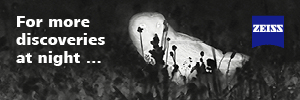| This article is incomplete. This article is missing one or more sections. You can help the BirdForum Opus by expanding it. |
Canada, Newfoundland and Labrador
Overview
A large ecological reserve in the Newfoundland / Labrador area of Canada described as "The most accessible seabird colony in North America."
One of seven protected seabird ecological reserves, it's been described as a "wonderland" for birdwatchers with its thousands upon thousands of a myriad of species of seabirds.
Add into that the natural setting and potential to sight whales offshore during their migration, as well as icebergs, and a picture of what this place is all about begins to emerge. [2]
Birds
Notable Species
Notable, as it could apply to Cape St Mary's Ecological Reserve, can cover a significant cross section. It's rugged, natural setting is readily apparent as soon as you arrive. Its reputation as a special place for seabirds is another consideration. And not "just" seabirds, but the potential for sheer numbers of them.
One source notes 381 species of birds reported here with 4 of those being introduced and 9 of them are globally threatened. []
Colonies of Northern Gannet, Common Murre, Black-legged Kittiwake as well as nesting pairs of Thick-billed Murre, Black Guillemot, and Razorbill are some of the species here that combine to give it such a diverse bird population.
Taking all this into consideration, it's a notable place for sure.
Rarities
Some of the species recorded as rare for this area[1] include the Greater White-fronted Goose, Eared Grebe, White-winged Dove, Black-billed Cuckoo, Common Nighthawk, Common Swift, Anna's Hummingbird, Corn Crake, Sandhill Crane, American Avocet, Common Ringed Plover, Stilt Sandpiper, South Polar Skua, Little Gull, White-tailed Tropicbird, Pacific Loon, Black-browed Albatross, Brown Booby, American White Pelican, Great Egret, Glossy Ibis, Turkey Vulture, Golden Eagle, Northern Saw-whet Owl, Red-bellied Woodpecker, Eastern Phoebe, Warbling Vireo, Eurasian Jackdaw, Violet-green Swallow, Blue-gray Gnatcatcher, Marsh Wren, Brown Thrasher, Varied Thrush, Fieldfare, Northern Wheatear, White Wagtail, Hoary Redpoll, Field Sparrow, Yellow-breasted Chat, Orchard Oriole, Prothonotary Warbler, Western Tanager.
Check-list
Birds you can see here include:
Blue-winged Teal, Willow Ptarmigan, Red-necked Grebe, Mourning Dove, American Coot, Semipalmated Plover, Ruddy Turnstone, Parasitic Jaeger, Thick-billed Murre, Herring Gull, Common Loon, Wilson's Storm-Petrel, Great Shearwater, Northern Gannet, Double-crested Cormorant, Great Blue Heron, Osprey, American Goshawk, Short-eared Owl, Belted Kingfisher, Black-backed Woodpecker, Gyrfalcon, Least Flycatcher, Red-eyed Vireo, Northern Shrike, American Crow, Boreal Chickadee, Horned Lark, Barn Swallow, Ruby-crowned Kinglet, Red-breasted Nuthatch, Brown Creeper, Winter Wren, Northern Mockingbird, Swainson's Thrush, Cedar Waxwing, House Sparrow, American Pipit, Common Redpoll, Snow Bunting, Fox Sparrow, Red-winged Blackbird, Black-and-white Warbler, Rose-breasted Grosbeak.
Other Wildlife
"to do"
Site Information
History and Use
"to do"
Areas of Interest
"to do"
Access and Facilities
Saint John's International Airport (YYT), is an airport offering commercial air service in this area.
Consult a trusted travel professional for up-to-date, specific information and the availability of alternate options. Couple that with the numbers of species calling here. A notable place for sure.
Contact Details
"to do"
References
- Lepage D. (2020) Avalon Peninsula-St John's Bird Checklist - Avibase - Bird Checklists of the World. Retrieved 31 August 2020
- Newfoundland/Labrador Tourism - Cape St Mary's
Recommended Citation
- BirdForum Opus contributors. (2024) Cape St. Mary's Ecological Reserve. In: BirdForum, the forum for wild birds and birding. Retrieved 26 April 2024 from https://www.birdforum.net/opus/Cape_St._Mary%27s_Ecological_Reserve
External Links
Maps
Content and images originally posted by Cemetery_man
Reviews
JTF's review Having been raised in Newfoundland & have visited over 20 countries, this is one of the best sites in the world for Sea Birds. Pros
- Ideal Both Sea Birds & Scenery
Cons
- The Drive from Ontario





